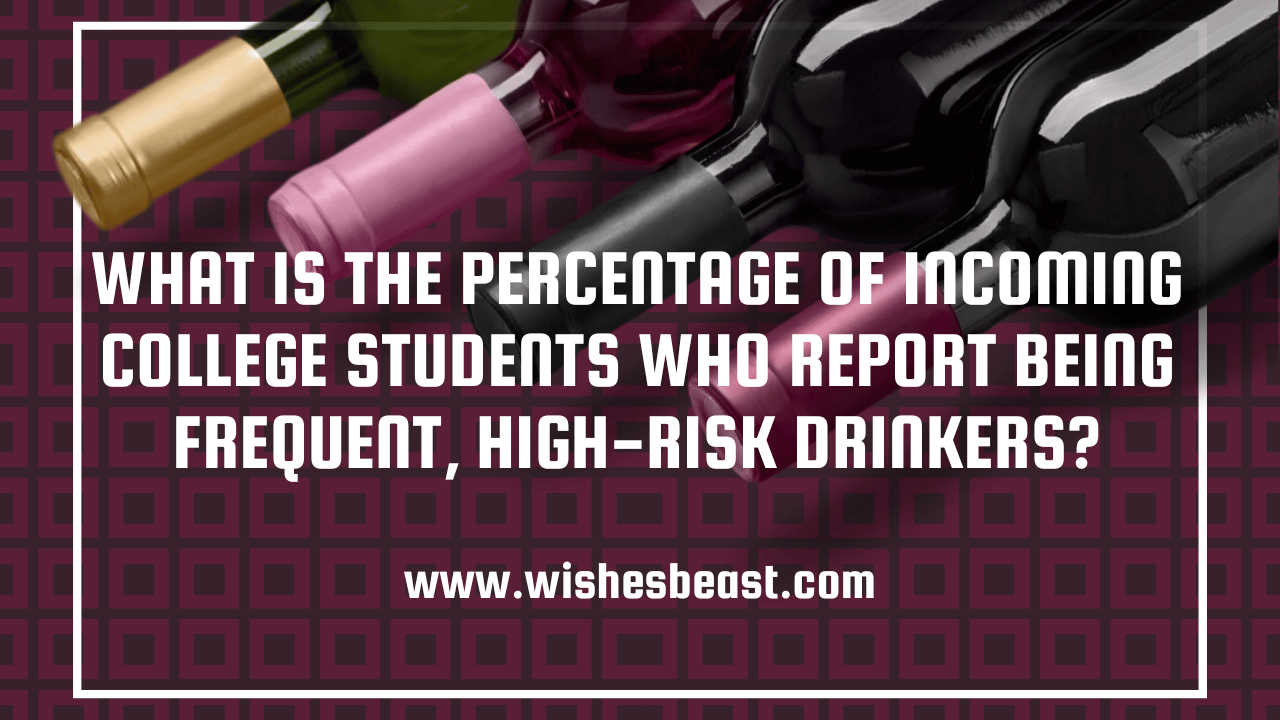As a new generation of students embarks on their journey in higher education, understanding their behaviors, particularly their drinking habits, is essential for promoting their health and academic success. In this comprehensive analysis, we’ll explore the percentage of incoming college students who report being frequent, high-risk drinkers, along with its implications and strategies to address it.
What is the Percentage of Incoming College Students who Report Being Frequent, High-Risk Drinkers?

According to research, the percentage of incoming college students who engage in high-risk drinking varies depending on how it is defined and measured. However, a study by the National Institute on Alcohol Abuse and Alcoholism (NIAAA) found that nearly 30% of college students reported binge drinking, a high-risk behavior, within the past two weeks of their survey response.
Alcohol Use Among Incoming College Students

Why do incoming college students, or freshmen, engage in frequent high-risk drinking? Research points to a variety of factors, including the freedom of living away from parental supervision, peer influence, and the stress of transitioning to a new environment. These drinking behaviors can negatively impact students’ academic performance, mental health, and overall well-being, emphasizing the need for early intervention.
The Role of Gender

Studies have consistently shown gender differences in alcohol consumption among college students. Typically, male students report higher rates of alcohol use and more high-risk drinking behaviors than female students, highlighting the need for gender-specific prevention and intervention strategies.
Long-Term Effects

High-risk drinking in college, especially during the first year, can have far-reaching consequences. Not only does it increase the risk of academic difficulties and mental health issues, but it can also lay the groundwork for long-term alcohol dependence and other related health problems.
Addressing the Issue
Universities nationwide are implementing various strategies to combat high-risk drinking among students, such as providing alcohol education programs, offering mental health support services, and fostering a campus culture that promotes responsible drinking habits.
Prevention and Support
To address the prevalent issue of high-risk drinking among incoming students, universities are offering prevention programs and support services. These resources are aimed at reducing alcohol abuse, educating students about the risks associated with excessive alcohol consumption, and providing support for those who may be struggling with alcohol-related issues.
What is the Percentage of Incoming College Students who Report Being Frequent, High-Risk Drinkers?
Surveys and research offer a wealth of information about alcohol consumption among incoming students. By understanding these trends, colleges and universities can better tailor their prevention programs and interventions to the needs of their student populations.
Social and Cultural Impact
Drinking behaviors among college students are also influenced by social and cultural factors, such as fraternity or sorority participation, sporting events, and popular media. Addressing these influences is a crucial part of the puzzle in reducing high-risk drinking among students.
Changing Perspectives
Addressing the frequency of alcohol use among incoming college students requires a shift in perspective. Rather than focusing solely on the punitive measures, universities are now aiming to equip students with knowledge and resources to make informed decisions about their alcohol consumption. Education about alcohol’s effects, peer pressure resistance strategies, and healthy coping mechanisms for stress are becoming more central in this new perspective.
Resources and Support Services: A Helping Hand for Incoming College Students
Universities across the globe offer a variety of resources to support incoming students struggling with alcohol abuse. From counseling centers to peer support groups, these resources provide much-needed assistance and create a safe space for students to discuss their struggles, learn from others’ experiences, and develop healthier habits.
Prevention Programs Targeting Alcohol Use Among New College Students
The most effective way to combat high-risk drinking among incoming college students is to take a proactive approach. Many universities now implement prevention programs targeting first-year students, which include components such as alcohol education workshops, peer-led seminars, and early intervention for students identified as at-risk.
Social and Cultural Factors Influencing Drinking Behaviors
When addressing high-risk drinking among incoming college students, it’s crucial to consider the social and cultural factors influencing their behaviors. The prevalence of alcohol in college culture, perpetuated by media portrayals and social norms, often leads to a normalized view of high-risk drinking. Efforts to change these perceptions can play a pivotal role in reducing high-risk drinking among students.
Transition to College Life
The transition to college life is an exciting but potentially stressful time for students. This phase often coincides with an increase in alcohol consumption, as students may use alcohol to cope with the pressures and changes associated with starting college. Providing support during this transition period, such as through orientation programs and transition assistance services, can help mitigate the risk of high-risk drinking.
FAQs
1. What are the consequences of frequent, high-risk drinking among college freshmen?
Frequent, high-risk drinking can lead to academic difficulties, health issues, and increased risk of alcohol-related accidents and violence. It can also increase the risk of long-term alcohol dependency.
2. How does alcohol consumption among incoming students affect academic performance?
Excessive alcohol consumption can result in decreased academic performance due to hangovers, missed classes, poor study habits, and decreased concentration.
3. What strategies are universities implementing to address high-risk drinking among new college students?
Universities are adopting a range of strategies, from alcohol education programs to mental health support services, to foster a culture of responsible drinking and provide help for students who may be struggling with alcohol-related issues.
4. Are there gender differences in alcohol consumption rates among incoming college students?
Yes, typically, male students report higher rates of alcohol use and more high-risk drinking behaviors than female students.
5. What are the long-term effects of heavy drinking during the first year of college?
Heavy drinking during the first year of college can increase the risk of long-term alcohol dependency, health problems, and academic difficulties.
Also Read: Cold Island Breeding Chart: My Singing Monsters Breeding Guide (2023)
Final Words
The examination of high-risk drinking behaviors among incoming college students is a complex but crucial task. By understanding the prevalence, influences, and consequences of these behaviors, we can work towards creating a safer and healthier college environment. Remember, if you or someone you know is struggling with alcohol-related issues, don’t hesitate to reach out for help. There are resources available, and you’re not alone in this journey.

